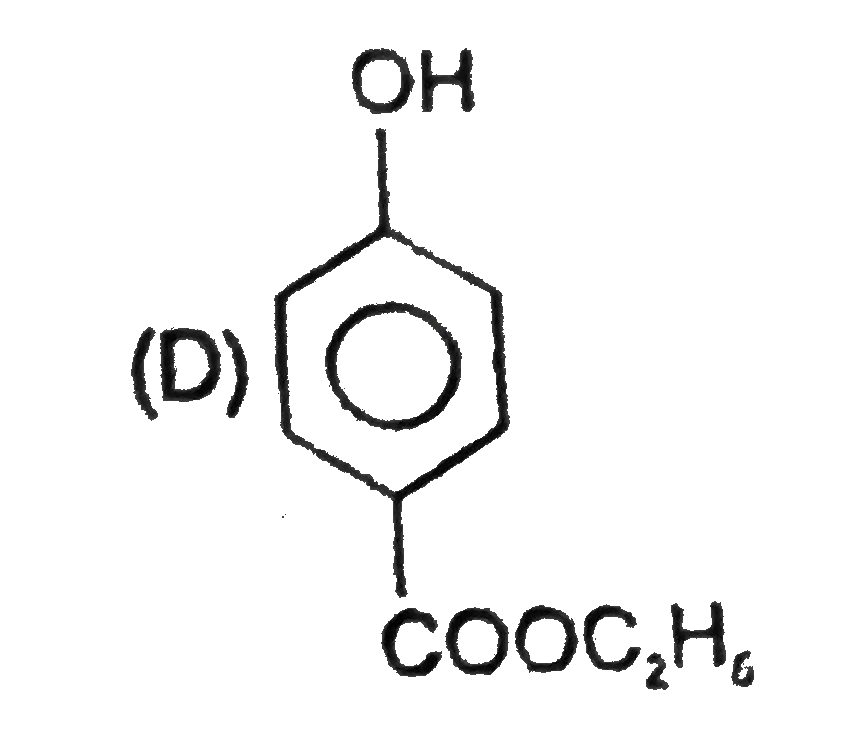Which of the following compounds would liberate two moles of methane when treated with methyl magnesium bromide ?
CH3−C∣OHH−CH2−C=CH
CH3−C∣∣O−CH2−CH2OH
CH3−C∣∣O−CH3∣CH−C∣∣O−CH3

The correct Answer is:A
To solve the question of which compound would liberate two moles of methane when treated with methyl magnesium bromide (CH3MgBr), we will analyze each compound step by step.
1. Understanding Methyl Magnesium Bromide (CH3MgBr):
- Methyl magnesium bromide is a Grignard reagent. The methyl group (CH3-) acts as a strong nucleophile and base, capable of deprotonating acidic hydrogens.
2. Identifying Acidic Hydrogens:
- We need to identify which of the given compounds has two acidic hydrogens that can be removed by CH3-.
3. Analyzing the First Compound:
- The first compound contains a hydroxyl group (OH) and a carbon-carbon triple bond (C≡C).
- The hydrogen from the OH group is acidic and can be removed by CH3-.
- The hydrogen from the terminal alkyne (C≡C) is also acidic and can be removed by CH3-.
- Therefore, this compound can liberate 2 moles of methane (one from OH and one from the terminal alkyne).
4. Analyzing the Second Compound:
- This compound has only one acidic hydrogen that can be removed. Thus, it will liberate only 1 mole of methane.
5. Analyzing the Third Compound:
- Similar to the second compound, this compound also has only one acidic hydrogen. Therefore, it will liberate only 1 mole of methane.
6. Analyzing the Fourth Compound:
- This compound also has only one acidic hydrogen that can be removed. Hence, it will liberate only 1 mole of methane.
7. Conclusion:
- Only the first compound can liberate 2 moles of methane when treated with methyl magnesium bromide. The other compounds can only liberate 1 mole of methane each.
Final Answer:
The compound that would liberate two moles of methane when treated with methyl magnesium bromide is option 1.
- Methyl magnesium bromide is a Grignard reagent. The methyl group (CH3-) acts as a strong nucleophile and base, capable of deprotonating acidic hydrogens.
- We need to identify which of the given compounds has two acidic hydrogens that can be removed by CH3-.
- The first compound contains a hydroxyl group (OH) and a carbon-carbon triple bond (C≡C).
- The hydrogen from the OH group is acidic and can be removed by CH3-.
- The hydrogen from the terminal alkyne (C≡C) is also acidic and can be removed by CH3-.
- Therefore, this compound can liberate 2 moles of methane (one from OH and one from the terminal alkyne).
- This compound has only one acidic hydrogen that can be removed. Thus, it will liberate only 1 mole of methane.
- Similar to the second compound, this compound also has only one acidic hydrogen. Therefore, it will liberate only 1 mole of methane.
- This compound also has only one acidic hydrogen that can be removed. Hence, it will liberate only 1 mole of methane.
- Only the first compound can liberate 2 moles of methane when treated with methyl magnesium bromide. The other compounds can only liberate 1 mole of methane each.
The compound that would liberate two moles of methane when treated with methyl magnesium bromide is option 1.
Topper's Solved these Questions
Similar Questions
Knowledge Check
Which of the following compounds is isomeric with
methyl vinyl ether?APropanalB1-propanolCEthyl methyl etherDDiethyl EtherWhich of the following compound would yield trialkylborane shown below when treated with BH3/THF?
 A2-methylbut-1-eneB2-methylbut-2-eneC3-methylbut-1-eneD3-methylbut-1-yne
A2-methylbut-1-eneB2-methylbut-2-eneC3-methylbut-1-eneD3-methylbut-1-yneWhich of the following gives two isomers of 3∘ alcohol, when treated with phenyl magnesium bromide ?
A B
B C
C D
D
Which of following reagents does not give isobutane when reacted with isobutyl magnesium bromide?
View SolutionIodine is liberated from KI solution when treated with :
View SolutionWhich of the following compound forms two stereoisomers when treated with NH2OH in weakly acidic medium?
View SolutionWhich one of the following compounds gives methane on treatement with water?
View SolutionWhich of the following compound give diastereomers when treated with Br2 in CCl4?
View Solution
